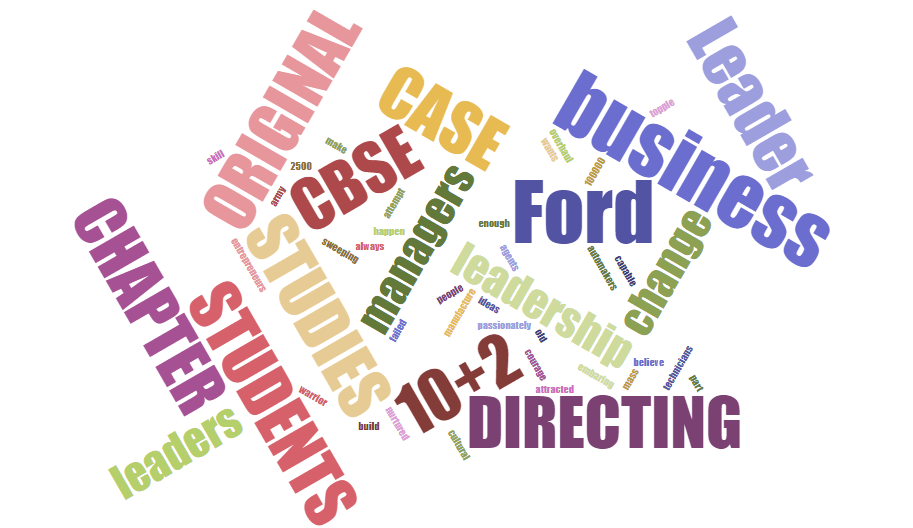For Class 12 CBSE Business Studies Students.
25 Multiple Objective Type Questions and Answers for chapter Directing Part-II
For Part -1 Directing MCQs – Click here
Q 1: Which function of management is concerned with giving instructions and guiding people in doing work?
- (a) Organizing
- (b) Staffing
- (c) controlling
- (d) directing
Ans: (d) Directing
Q 2: A hotel owner __________ his employees to complete certain activities for organizing a function, a teacher _________ his students to complete an assignment.
Fill in the above blanks the suitable function of management.
- (a) Organizing
- (b) Staffing
- (c) controlling
- (d) directing
Ans: (d) Directing
Q 3: What does directing refer to?
Ans: Directing refers to the process of instructing, guiding, counselling, motivating and leading people in the organisation to achieve its objectives.
Q 4: Which of the following key managerial function has elements of motivation, leadership and supervision.
- (a) Organizing
- (b) Staffing
- (c) controlling
- (d) directing
Ans: (d) Directing
Q 5: A manager has to perform this function along with planning, organizing, staffing and controlling while discharging his duties in the organisation.
Which of the following feature of directing is highlighted above?
- (a) Directing is a continuous process
- (b) Directing initiates action
- (c) Directing flows from top to bottom
- (d)Directing takes place at every level of management
Ans: (b) Directing initiates action
Q 6: We can observe that in organisations like Infosys, Tata, BHEL, HLL and the managers may change because without direction the organisational activities can not continue further.
Which of the following feature of directing is highlighted above?
- (a) Directing is a continuous process
- (b) Directing initiates action
- (c) Directing flows from top to bottom
- (d)Directing takes place at every level of management
Ans: (a) Directing is a continuous process
Q 7: Every manager can direct his immediate subordinate and take instructions from his immediate boss.
Which of the following feature of directing is highlighted above?
- (a) Directing is a continuous process
- (b) Directing initiates action
- (c) Directing flows from top to bottom
- (d)Directing takes place at every level of management
Ans: (c) Directing flows from top to bottom
Q 8: Every action in the organisation is initiated through _________________only.
Fill in the above blanks the suitable function of management.
- (a) Organizing
- (b) Staffing
- (c) Controlling
- (d) Directing
Ans: (d) Directing
Q 9: Through ____________ managers not only tell the people in the organisation as to what they should do, when they should do and how they should do but also see that instructions are implemented in proper perspective.
Fill in the above blanks the suitable function of management.
- (a) Organizing
- (b) Staffing
- (c) Controlling
- (d) Directing
Ans: (d) Directing
Q 10: Which of the following is not the importance of directing?
- (a) Helps to initiate action
- (b) Integrates employees efforts
- (c) Directing is a continuous process
- (d) Brings stability and balance in organisation
Ans: © Directing is a continuous process.
Q 11: A manager wants to introduce new system of accounting, there may be initial resistance from accounting staff, But if manager explains the purpose, provides training and motivates with additional rewards, the employees may accept the changes and cooperate with the manager. The above example highlights the importance of one of the functions of Management.
Fill in the above blanks the suitable function of management.
- (a) Organizing
- (b) Staffing
- (c) Controlling
- (d) Directing
Ans: (d) Directing
Q 12: If a supervisor guides his subordinates and clarifies their doubts in performing a task, it will help the worker to achieve work targets given to him. The above example highlights the importance of one of the functions of Management.
Fill in the above blanks the suitable function of management.
- (a) Organizing
- (b) Staffing
- (c) Controlling
- (d) Directing
Ans: (d) Directing
Q 13: _____ is the process of exchange of ideas, views, facts, feelings etc. between or among people to create common understanding.
Fill in the blank with one of the suitable element of directing.
- (a) Motivation
- (b) Supervision
- (c) Leadership
- (d) Communication
Ans: (d) Communication
Q 14: Arrange the following elements of communication process in order:
- (I) Media
- (ii) Message
- (iii) Sender
- (iv) Encoding
(a) (I), (ii), (iii), (iv)
(b) (iii), (ii), (iv), (I)
(c) (iv) (ii), (iii), (I)
(d) ((iii), (I), (iv), (ii)
Ans: (b)
Q 15: Which of the following is not the psychological barrier to communication?
- (a) Badly expressed message
- (b) Premature evaluation
- (c) Distrust
- (d) Lack of attention
Ans: (a) Badly expressed message
Q 16: Which of the following is the semantic barrier to communication?
- (a) Badly expressed message
- (b) Premature evaluation
- (c) Distrust
- (d) Lack of attention
Ans: (a) Badly expressed message
Q 17: If there is no reward or appreciation for a good suggestion, the subordinates may not be willing to offer useful suggestion.
Identify the above type of barrier to communication.
- (a) Unwillingness to communicate
- (b) Lack of proper incentive.
- (c) Distrust
- (d) Lack of confidence of superior on subordinate
Ans: (b) Lack of proper incentive.
Q 18: State the meaning of informal Communication.
Ans: Communication that takes place without following the formal lines of communication is called Informal communication.
Q 19: Application of grant of leave, submission of progress report , request for grants etc. are examples of which of the following type of communication?
- (a) Upward communication
- (b) Horizontal communication
- (c) Downward communication
- (d) Informal Communication
Ans: (a) Upward communication
Q 20 : A production manager may contact marketing manager to discuss about schedule of product delivery, product design, quality etc.are example of which of the following type of communication?
- (a) Upward communication
- (b) Horizontal communication
- (c) Downward communication
- (d) Informal Communication
Ans: (b) Horizontal communication.

